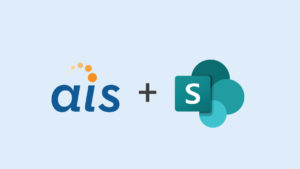 It was more than 10 years ago when AIS first began to explore and envision the idea of using SharePoint as an application development platform. Although Office was a great product to author content, it did not provide a means to manage that content. From the moment we heard that Microsoft was going to provide a centralized, managed repository for Office and other forms, documents and records we immediately started to envision solutions for our clients, along with a laundry list of new features.
It was more than 10 years ago when AIS first began to explore and envision the idea of using SharePoint as an application development platform. Although Office was a great product to author content, it did not provide a means to manage that content. From the moment we heard that Microsoft was going to provide a centralized, managed repository for Office and other forms, documents and records we immediately started to envision solutions for our clients, along with a laundry list of new features.
Automated workflow and integration of development tools were immediate needs. It wasn’t until 2007 that we felt we had enough features to address our client’s needs to automate paper-based workflows. You can view the whitepaper we published on January 30, 2007 (the very day SharePoint 2007 was released) on our YouTube channel. We published an updated version on the day of the 2010 release, which was a major release in terms of features and performance that also marked the expansion of Search features.
READ MORE: SharePoint App Dev Platform: The Journey So Far & the Road Ahead
Over the years we have built countless large-scale, human-to-human (and human-to-system) workflow solutions. Some support tens of thousands of users, hundreds of thousands of workflows, and hundreds of millions of documents and records. We’ve built task, event, investigation, legal matter, and assessment management systems (just to name a few) across DoD and the military, many Intel agencies and some civilian agencies in the public sector. In the commercial sector our clients range from the largest law firms, international NGOs with far-flung offices, health plans, wealth and financial management, among many others.
Today, SharePoint 2013 has fully matured. It finally contains all the features we need for a fully-featured application development platform. We now have enumerable building blocks which allow us to write less code and deliver solutions for a fraction of the cost of other solutions.
Some highlights include:
Dramatically improved Search capability. Microsoft integrated their FAST Search product with SharePoint Search to provide a rich search capability with analytics.
Support for modern/leading UX development. SharePoint 2013 uses a faster and lightweight UI based on HTML5. Additionally, there is much better support for mobile browsers out of the box. Unlike previous versions of SharePoint, the SharePoint 2013 UI is intended to be rendered in HTML5 for an optimal experience. In addition to a more efficient traditional desktop browser experience, HTML5 supports a wider array of clients as most modern touch-based devices support HTML5.
The Application Store Model for both public and private application stores provides a structured way to customize SharePoint. There is a new application programming Interface (API – Client-Library) so SharePoint can be customized without external to product functions, so applications can be better managed and released. While ISVs like Telerik will offer applications you can buy, this is also the means for enterprises to develop, release and manage their own custom applications.
Enhanced collaboration / social media integration, including Yammer, SkyDrive Pro and enhanced activity feeds. Social features are expected to transform businesses by increasing employee engagement and improving collaboration, making teams more effective. With this view, SharePoint 2013 has these features interwoven into the platform with a vision to continue to enhance and expand on these initial social platform features.
Truly robust and decoupled workflow engine. Workflows are one of the most used features across all of our implementations. SharePoint is uniquely appropriate to document, record and form laden human workflow solutions. This enhancement enables virtually any workflow need to be delivered regardless of complexity.
Expanded digital dashboard and reporting through PowerView enhancements in SharePoint 2013 including drill down, hierarchies and printing. PowerView is perhaps the most differentiating feature of the Microsoft Business Intelligence stack and these features light up only with SharePoint 2013.
READ MORE: Why Migrate to SharePoint 2013? (whitepaper)
[pullquote]If you are only using SharePoint for centralized document management and collaboration you are missing the biggest value proposition for software you already own.[/pullquote]These are only some of the highlights. As developers, we especially like the improved tooling and integration with Visual Studio. In the end, if you are only using SharePoint for centralized document management and collaboration you are missing the biggest value proposition for software you already own. Any paper-based process or human workflow system can be completely automated at a fraction of the cost of alternative means.
AIS is among the leading Microsoft-focused solution providers in the United States and a recognized authority in delivering SharePoint solutions. Take a look at our SharePoint Services Offerings as a place to get started, including our new SharePoint Quick Start Project and Upgrade Planning Project.
And finally, please take some time to view our latest webinar, which goes into more depth about the value proposition of these and other new features in the new SharePoint 2013.
Part One:
Part Two:






